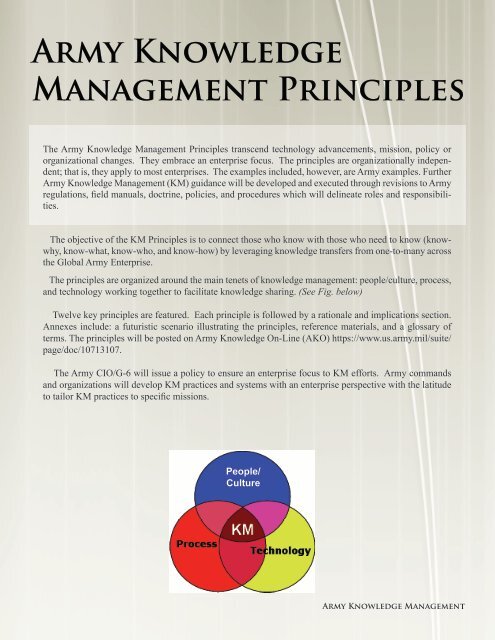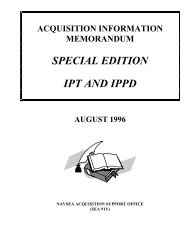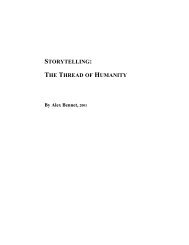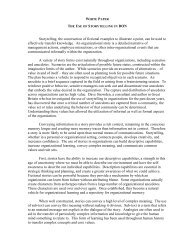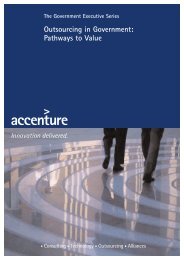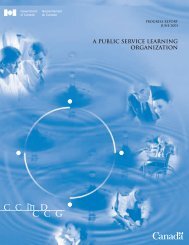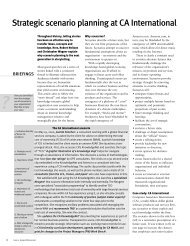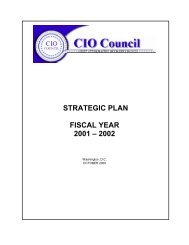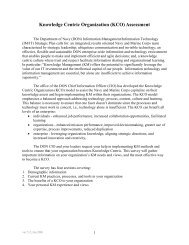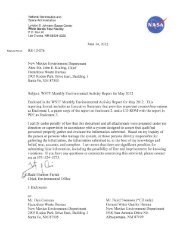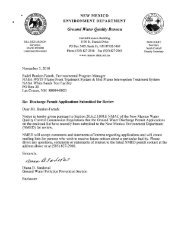ARMy KNOwlEdGE MANAGEMENt PRiNciPlES - NASA Wiki
ARMy KNOwlEdGE MANAGEMENt PRiNciPlES - NASA Wiki
ARMy KNOwlEdGE MANAGEMENt PRiNciPlES - NASA Wiki
Create successful ePaper yourself
Turn your PDF publications into a flip-book with our unique Google optimized e-Paper software.
Army Knowledge<br />
Management Principles<br />
The Army Knowledge Management Principles transcend technology advancements, mission, policy or<br />
organizational changes. They embrace an enterprise focus. The principles are organizationally independent;<br />
that is, they apply to most enterprises. The examples included, however, are Army examples. Further<br />
Army Knowledge Management (KM) guidance will be developed and executed through revisions to Army<br />
regulations, field manuals, doctrine, policies, and procedures which will delineate roles and responsibilities.<br />
The objective of the KM Principles is to connect those who know with those who need to know (knowwhy,<br />
know-what, know-who, and know-how) by leveraging knowledge transfers from one-to-many across<br />
the Global Army Enterprise.<br />
The principles are organized around the main tenets of knowledge management: people/culture, process,<br />
and technology working together to facilitate knowledge sharing. (See Fig. below)<br />
Twelve key principles are featured. Each principle is followed by a rationale and implications section.<br />
Annexes include: a futuristic scenario illustrating the principles, reference materials, and a glossary of<br />
terms. The principles will be posted on Army Knowledge On-Line (AKO) https://www.us.army.mil/suite/<br />
page/doc/10713107.<br />
The Army CIO/G-6 will issue a policy to ensure an enterprise focus to KM efforts. Army commands<br />
and organizations will develop KM practices and systems with an enterprise perspective with the latitude<br />
to tailor KM practices to specific missions.<br />
People/<br />
Culture<br />
Army Knowledge Management
What is Army Knowledge Management?<br />
Knowledge management is a discipline<br />
that promotes an integrated<br />
approach to identifying, retrieving,<br />
evaluating, and sharing an enterprise’s<br />
tacit and explicit knowledge<br />
assets to meet mission objectives.<br />
The objective of the principles is to<br />
connect those who know with those<br />
who need to know (know-why, knowwhat,<br />
know-who, and know-how)<br />
by leveraging knowledge transfers<br />
from one-to-many across the Global<br />
Army Enterprise.<br />
End State<br />
Implementing these principles will<br />
create a culture of collaboration<br />
and knowledge sharing in the Army<br />
where key information and knowledge<br />
is “pushed and pulled” within<br />
the global enterprise to meet mission<br />
objectives -- an Army where<br />
good ideas are valued regardless<br />
of the source, knowledge sharing is<br />
recognized and rewarded and the<br />
knowledge base is accessible without<br />
technological or structural barriers.<br />
Introduction<br />
The challenges facing the US Army and the national security community<br />
cut across agency missions, organizational boundaries, and uncertain and<br />
rapidly changing political and military environments. In multi-disciplinary,<br />
multi-organizational, and joint military environments, those who innovate,<br />
learn, rapidly adapt, and act decisively will prevail against adversaries.<br />
This enduring principle applies across the Army enterprise from the generating<br />
force to the operational force, from business systems to warfighting<br />
systems-of-systems, and from military strategy to squad-level tactics.<br />
The challenge is to connect those who know with those who need to know<br />
(know-why, know-what, know-how, and know-who) by leveraging tacit<br />
and explicit knowledge transfers from one-to-many across the enterprise<br />
to meet mission objectives. Military strategy and operations depend on<br />
consistent but rapidly adaptable decision making across the Army, other<br />
military services and agencies, allies, and with non-governmental organizations.<br />
Hence, a natural tension exists when each Army unit or organization<br />
brings its own policies, procedures and technology to collaborate and share<br />
their intellectual capital across their unit, discipline, or function. Without<br />
consistent strategy and policy, units and commands will generate islands<br />
of information and knowledge inaccessible to others. This is a recipe for<br />
disaster from an enterprise perspective.<br />
The Army Knowledge Management Principles create a consistent framework<br />
so warfighters and business stewards can innovate, evaluate alternate<br />
courses of actions within context of local conditions, and act quickly and<br />
decisively. Most importantly, the Army Knowledge Management Principles<br />
will help preserve tacit and explicit knowledge and accelerate learning<br />
as units and personnel rotate in and out of theaters or organizations. They<br />
also serve as grist for revised doctrine. Additionally, the Army Knowledge<br />
Management Principles anchor knowledge management efforts as an Army-wide<br />
enterprise function vice a unit or business function. For example,<br />
it makes sense that, if the 2nd Brigade Combat Team of 10th Mountain<br />
Division discovers new ways in which insurgents are triggering and deploying<br />
IED/EFP’s in Afghanistan that the context-specific tacit and explicit<br />
knowledge is shared with Soldiers and Marines in Iraq, Philippines,<br />
Djibouti, Colombia and with Soldiers in CONUS who will soon deploy. It<br />
also makes sense when new procurement procedures are developed at the<br />
Army Materiel Command they are shared with other commands who procure<br />
materiel and services.<br />
By adhering to and applying the following principles, the Army, as<br />
an enterprise, will accelerate individual, team, and organization learning to<br />
meet mission objectives.<br />
2<br />
Army Knowledge<br />
Management
Knowledge<br />
Management Principles<br />
The principles provide authoritative guidance to Army Commands and organizations developing or engaging<br />
in knowledge management efforts. Annex A provides definitions of the terms.<br />
People/Culture Dimension<br />
Principle 1 – Train and educate KM leaders, managers,<br />
and champions.<br />
Rationale: To create a culture of collaboration, the<br />
Army needs to educate the next generation KM<br />
change agents who understand KM Principles and<br />
technologies and can effect change to accelerate<br />
meeting mission objectives.<br />
Implications: Curriculum development and instructional<br />
delivery methods identified to train and<br />
educate the force in KM competency at all levels of<br />
the Army.<br />
Principle 2 - Reward knowledge sharing and make<br />
knowledge management career rewarding.<br />
Rationale: What gets rewarded in organizations<br />
gets done. Reward structures guide organizational<br />
and individual behavior.<br />
Implications: Establish KM career fields, where<br />
appropriate, and insert performance elements into<br />
NSPS, OERs, and NCOERs to evaluate knowledge<br />
sharing contributions.<br />
Principle 3 – Establish a doctrine of collaboration.<br />
Rationale: A collaborative environment fosters<br />
new ideas, understanding, and ways to execute the<br />
commander’s intent.<br />
Implications: Leaders need to incorporate the Core<br />
Principles of Collaboration into their business procedures<br />
and human resources practices.<br />
Core Principles of Collaboration<br />
1. Responsibility to Provide - “need-to-share”<br />
should be replaced by “responsibility to provide”.<br />
2. Empowered to Participate - Soldiers and Civilians<br />
are empowered to participate and share insight<br />
in virtual collaborative communities without seeking<br />
prior permission.<br />
3. User-driven - Collaborative communities are<br />
self-defining, self creating, and adaptable. Users<br />
own the collaborative community, not IT providers.<br />
Principle 4 – Use every interaction whether faceto-face<br />
or virtual as an opportunity to acquire and<br />
share knowledge.<br />
Rationale: Continuous learning is an expected dayto-day<br />
activity. Learning faster than adversaries or<br />
competitors yields short and long-term results.<br />
Implications: Leaders need to frame day-to-day<br />
activities as learning opportunities to accelerate<br />
knowledge acquisition and transfer. Promote<br />
learning in teams and in informal and formal social<br />
networks.<br />
Principle 5 – Prevent knowledge loss.<br />
Rationale: Knowledge is perishable. It has a life<br />
cycle. The life cycle can’t begin until it is documented<br />
and assessed for its value.<br />
Implications: Assess what is valuable from past<br />
activity, document it, and share with those who<br />
need to know.<br />
Army Knowledge<br />
Management<br />
3
Process Dimension<br />
Principle 6 – Protect and secure information and<br />
knowledge assets.<br />
Rationale: Denying adversaries access to key information<br />
gives US and coalition forces the decisive<br />
advantage to securely communicate and collaborate<br />
across geographic and organizational boundaries.<br />
Implications: Balance risks regarding “need to<br />
know” against “need to protect”. Requires leaders<br />
of knowledge communities to comply with relevant<br />
information assurance regulations and policies.<br />
Principle 7 – Embed knowledge assets (links,<br />
podcasts, videos, documents, simulations, wikis...)<br />
in standard business processes and provide access<br />
to those who need to know.<br />
Rationale: Leverage digital media to add context,<br />
understanding, and situational awareness to operations<br />
and business activities.<br />
Implications: It is incumbent on leaders to creatively<br />
embed and use digital media (podcasts,<br />
videos, simulations, wikis…) in training routines<br />
and operations to add to or leverage the existing<br />
knowledge assets of the Army. Convert intellectual<br />
capital (ideas, best known practices) to structural<br />
capital (anything that is digitized and accessible<br />
and searchable by others). Verify content for legality<br />
and desired outcome.<br />
Principle 8 – Use legal and standard business rules<br />
and processes across the enterprise.<br />
Rationale: Established business rules and processes<br />
are repeatable, reducing learning curves and<br />
promoting consistent quality products and services.<br />
Implications: Follow standard business rules and<br />
processes set by the Army and the Department of<br />
Defense (DoD). Modify and evolve business rules<br />
to meet the commander’s intent and quickly adapt<br />
business processes to meet or anticipate emerging<br />
threats or business opportunities (situational awareness).<br />
Lean Six Sigma and continuous process<br />
improvement principles apply.<br />
Technology Dimension<br />
Principle 9 – Use standardized collaborative tool<br />
sets.<br />
Rationale: Training on and using common collaborative<br />
software tool sets reduces training and maintenance<br />
costs while creating a common platform<br />
for data, information, and knowledge exchange in<br />
theaters and with other partners and organizations.<br />
It reduces impediments to searching for relevant<br />
knowledge across the enterprise.<br />
Implications: Use approved Army and DoD collaborative<br />
tools sets. Train and deploy with them.<br />
Provide access to structural capital to accelerate<br />
learning curves and adopt/modify best known<br />
practices.<br />
Principle 10 – Use Open Architectures to permit<br />
access and searching across boundaries.<br />
Rationale: Create seamless and ubiquitous serviceon-demand<br />
when one client application requests<br />
one or more services for another application which<br />
provides complimentary services.<br />
Implications: KM applications need to be designed<br />
and operate with an enterprise focus,<br />
permitting access and searching across systems<br />
and organizations without technical or structural<br />
impediments.<br />
Principle 11 – Use a robust search capability to<br />
access contextual knowledge and store content for<br />
discovery.<br />
Rationale: With the exception of classified information,<br />
knowledge bases should be accessible and<br />
searchable by search engines that deliver contextual<br />
knowledge and information.<br />
4<br />
Army Knowledge<br />
Management
Implications: In the design and operation of KM<br />
systems, leaders need to ensure that there are no<br />
organizational or technical barriers blocking access<br />
to digital media residing in knowledge bases. Use<br />
appropriate content management principles.<br />
Principle 12 – Use portals that permit single signon<br />
and authentication across the global enterprise<br />
including partners.<br />
Rationale: Using the Army’s enterprise portal for<br />
access and authentication lessens confusion for<br />
users and provides a standard process for accessing<br />
enterprise knowledge assets while reducing<br />
total cost of ownership of other portals, websites or<br />
knowledge networks.<br />
Implications: Use AKO/DKO or successors as<br />
your portal of first choice. AKO is centrally funded<br />
by the HQDA CIO/G-6 and is available to Army<br />
commands and organizations at no additional cost.<br />
Army Knowledge<br />
Management<br />
5
The information below illustrates<br />
key knowledge management<br />
principles. The principles are<br />
italicized in paranthesis in the<br />
article.<br />
Principle 1 – Train and educate KM<br />
leaders, managers, and champions.<br />
Principle 2 – Reward knowledge<br />
sharing and make KM career rewarding.<br />
Principle 3 – Establish a doctrine of<br />
collaboration.<br />
Principle 4 – Use every interaction<br />
whether face-to-face or virtual as<br />
an opportunity to acquire and share<br />
knowledge.<br />
Principle 5 – Prevent knowledge<br />
loss.<br />
Principle 6 – Protect and secure<br />
information and knowledge assets.<br />
Principle 7 – Embed knowledge<br />
assets (links, podcasts, videos,<br />
documents...) in standard business<br />
processes and provide access to<br />
those who need to know.<br />
Principle 8 – Use standard business<br />
rules and processes across the<br />
enterprise.<br />
Principle 9 – Use standardized collaborative<br />
tools sets.<br />
Principle 10 – Use Open Architectures<br />
to permit access and searching<br />
across boundaries.<br />
Principle 11 – Use a robust search<br />
capability to access contextual<br />
knowledge and store content for<br />
discovery.<br />
Principle 12 – Army Knowledge Online<br />
(AKO) or Defense Knowledge<br />
Online (DKO) is the preferred portal<br />
and access point to all Army enterprise<br />
knowledge assets.<br />
6<br />
Army Knowledge<br />
Management<br />
The SPC Alfredo Story<br />
-An Army “Enterprise” Future Perspective-<br />
Annex 1 – Futuristic scenario illustrating the Army Knowledge Management<br />
Principles<br />
The SPC Alfredo story highlights the principles of Army Knowledge<br />
Management. All twelve principles are represented either explicitly<br />
or they are implied. The purpose of embedding the principles in the<br />
story is to give the reader of the strategy examples of the principles<br />
in an understandable context. The Army Knowledge Management<br />
Principles are listed in the sidebar.<br />
Time & Setting:<br />
1810 hours, August 15, 2012, “Ft. Apache” a forward operating base<br />
along the Afghanistan/ Pakistan border in the Konar Province<br />
Act 1 – Mission Prep<br />
SSG Santiago Dominguez of the 1-41 Infantry, 1st ID, is preparing<br />
for tomorrow’s mission; recon of new entry routes by Taliban forces<br />
into Afghanistan. Eyes and ears and boots on the ground are still important<br />
even in a high tech SIGINT world where satellites and sensors can<br />
detect body movement day or night. He activates his handheld PDA that<br />
looks like a ruggedized iPod via voice commands and gains access to the<br />
DKO pocket portal using a secure wireless connection (Principles 12,6).<br />
Multinational Information Sharing (MNIS) improvements allow timely,<br />
trusted and accurate information to be passed among coalition partners.<br />
DKO has pushed the latest information on the Taliban movement to<br />
him (Principles 8,9). He couples that information with mission specific<br />
intelligence from his superiors.<br />
He wants to put the intelligence in context. He also downloads three<br />
5-minute podcasts on IED/EFP’s from his IED community of practice<br />
(KnIFE) (Principles 7,5). One “cast” was produced a week ago by SPC<br />
Bruce Hansen who, saved him in 2009 by providing a great IED “cast”<br />
showing close-up and panoramic views of a craftily placed IED in Helmand<br />
province (Principles 3,5). He downloads another “cast” provided<br />
by Marines stationed in Djibouti (Principle 11). It’s based on operations<br />
in Somalia and other unnamed E. African countries. The third “cast” is<br />
from 10th Army Special Forces Group in Bogotá, Colombia. They have<br />
experience with the Revolutionary Forces of Colombia who, years ago,<br />
learned it from Irish Republican Army operatives. Dominquez inherently<br />
trusts the “just-in-time” knowledge in the “casts” since they are produced<br />
by operators in the field. Couple that with the fact that fellow Soldiers<br />
and Marines in the IED community have given these “casts” 4-star<br />
ratings using the DKO rating scheme (Principle 4). He bundles all the<br />
background information, intel, and podcasts and sends it to each squad<br />
member’s handheld PDA’s. He expects the troops to watch the podcasts<br />
with the same enthusiasm as they do the latest music video (Principle 4).
2015 hours<br />
In the dim light of their spartan quarters, Dominguez calls his squad<br />
together to discuss Thursday’s mission (Principle 4). The squad members<br />
know that the “fused” information may provide context-specific<br />
knowledge that may save their lives. Dominguez focuses the discussion<br />
on key elements of the podcasts re: location of IED’s and new triggering<br />
mechanisms in mountain operations (Principle 4). He wants SPC Tony<br />
Alfredo to pay close attention since at “0-dark thirty”, Alfredo will be<br />
on point. They talk about and share what they learned from the podcasts<br />
in language that their mothers would not approve of (Principles 4,3).<br />
They also talk about producing their own podcast on IED/EFP’s since<br />
they have six months of experience in-country and have new insight into<br />
how the bad guys from S. Waziristan are planting IED’s (Principles 4,3).<br />
They are proud of their accomplishments to-date and have good ideas to<br />
share (Principles 2,3).<br />
Act 2 - Mission Execution<br />
August 16, 2012 0530 hours<br />
Principle 2 - Reward knowledge<br />
sharing and make knowledge management<br />
career rewarding.<br />
Principle 3 – Establish a doctrine of<br />
collaboration.<br />
Principle 4 – Use every interaction<br />
whether face-to-face or virtual as<br />
an opportunity to acquire and share<br />
knowledge.<br />
Principle 5 – Prevent knowledge<br />
loss.<br />
Principle 7 – Embed knowledge<br />
assets (links, podcasts, videos,<br />
documents...) in standard business<br />
processes and provide access to<br />
those who need to know.<br />
SSG Dominguez’s squad pulls out of Ft. Apache. But things start going<br />
to hell in a hand basket before the squad arrives at their designated<br />
recon vantage point. The bad guys hit Dominguez’s squad with RPG’s<br />
and small arms fire. They even lob in a few mortar shots that land nearby.<br />
One lucky mortar shell explodes next to Alfredo and sends a burning<br />
piece of shrapnel into his neck. The shrapnel penetrates the left side<br />
of his neck in that vulnerable area between his flak vest and helmet. It<br />
lodges close to the spine. Alfredo’s comrades let loose with suppressing<br />
fire while SPC Jackson, the medic, rushes to Alfredo’s aid. He assures<br />
him he is OK but he cannot move his legs or arms. Alfredo is raced<br />
back to Ft. Apache where he is fitted with a medical “bracelet”, that is<br />
RFID/GPS encoded, containing personal information, his initial diagnosis,<br />
and a medical priority indicator. He is MEDEVAC’d to Bagram<br />
where his condition is already displayed on computer screens before he<br />
arrives. Maj Marie Cou, a USAF neurosurgeon, is on standby. Prior to<br />
Alfredo’s arrival she accesses “Spinal Tap,” her community of neuro and<br />
spinal surgeon’s, quickly refreshes her memory re: the steps she needs to<br />
go through since she is a head surgeon and not a neck specialist (Principle<br />
4). She feels confident that she has the collective knowledge base<br />
of armed forces and trauma surgeon communities at her disposal (Principles<br />
4, 5, 7).<br />
Act 3 - Mission Aftermath<br />
0730 hours<br />
Alfredo is wheeled into the station hospital. He is conscious, but<br />
afraid because he can’t move his limbs. Maj Cou stabilizes SPC Alfredo<br />
and confirms the extent of the damage and accompanying paralysis.<br />
Army Knowledge<br />
Management<br />
7
Principle 3 – Establish a doctrine of<br />
collaboration.<br />
Principle 4 – Use every interaction<br />
whether face-to-face or virtual as<br />
an opportunity to acquire and share<br />
knowledge.<br />
Principle 5 – Prevent knowledge<br />
loss.<br />
Principle 6 – Protect and secure<br />
information and knowledge assets.<br />
Principle 8 – Use standard business<br />
rules and processes across the<br />
enterprise.<br />
Principle 9 – Use standardized collaborative<br />
tool sets.<br />
The initial medical assessment starts a cascading series of “electronic”<br />
events all triggered by information contained in Alfredo’s medical bracelet.<br />
She prepares SPC Alfredo for transport to Landstuhl in Germany for<br />
delicate spine surgery and continuing treatment at DeWitt Army Hospital<br />
at Ft. Belvoir.<br />
Landstuhl, Germany<br />
Prior to surgery Col Anderson, chief of surgery at Landstuhl, posts a<br />
30 second video request to his trauma surgeon CoP for the latest on less<br />
invasive surgical techniques in neck surgery (Principle 3). He’s hoping<br />
something new will help him minimize the risk of permanent paralysis<br />
in Alfredo’s case. He gets a quick response from Dr. Phillip Black, a<br />
head and neck surgeon at Georgetown Hospital (Principles 8,9). It’s<br />
like a Vulcan mind-meld between the two of them as they video chat via<br />
DKO about the nuances of a new technique, each using plastic anatomically<br />
correct replicas of the neck to illustrate their key points (Principles<br />
4,5). Col Anderson feels more confident with his new found knowledge<br />
and successfully removes the shrapnel from SPC Alfredo’s neck. The<br />
extent of his paralysis is still unknown. Time will tell.<br />
At the same time, SPC Alfredo’s wife and parents are notified inperson<br />
by LTC Harris of the extent of his injuries. He suggests that<br />
they may want to go to a DKO website so they can track his medical<br />
progress on a site custom tailored to his type of injury. The site tracks<br />
SPC Alfredo’s whereabouts, much like FedEx tracks packages, but with<br />
all resources and links provided tailored to the extent and nature of his<br />
injuries. The site shows where he is in the hospital (radiology, surgery,<br />
recovery) and will also track his progress home via Andrews AFB to<br />
DeWitt Army Hospital.<br />
8<br />
Army Knowledge<br />
Management<br />
Human Resource Command’s Casualty and Mortuary Affairs Operations<br />
Center notifies SPC Alfredo’s family about its services. A profile of<br />
SPC Alfredo and his family is compiled and used to inform the Wounded<br />
Warrior Comprehensive Recovery Team at DeWitt. No longer focused<br />
solely on the treatment and rehabilitation of wounded Soldiers, this team<br />
uses the profile information to quickly assess the types of services and<br />
support Mrs. Alfredo may need upon her arrival at the hospital. Concurrently,<br />
the Family Readiness Support Assistant back at Alfredo’s home<br />
station, Ft. Riley, has been notified and started their FRG activities. In a<br />
short amount of time, SPC Alfredo’s and his Family’s support network<br />
has expanded to include his commander and unit, the FSG at Ft. Riley,<br />
and the Comprehensive Recovery Team at DeWitt. Based on their<br />
credentials, DKO grants appropriate levels of access to each so they<br />
can track the evacuation, treatment and rehabilitation of SPC Alfredo<br />
(Principle 6). Benefits and entitlements are delivered to SPC and Mrs.<br />
Alfredo without unnecessary applications and bureaucracy that plagued<br />
the system in the past. Even the disposition of his field equipment back<br />
in Afghanistan is accounted for and inventoried.
SPC Alfredo’s recovery and rehabilitation is slow at first, but accelerates<br />
after he receives words of encouragement and videos from his<br />
buddies in theater. In the past, this would be a period of significant angst<br />
for the Soldier and his Family; a potential end to what was a promising<br />
career, loss of income, job security, and dealing with a possible lifelong<br />
disability. Today, the Comprehensive Recovery Team using an automated<br />
disability process, web-based knowledge centers, interactive tools<br />
to track medical progress and accompanying services, serves as a virtual<br />
Soldier-Family Assistance Center. Much of the family angst has been<br />
eliminated. SPC Alfredo and his Family can now make informed decisions<br />
about his future. Fortunately for him, he recovers from his injuries<br />
and is reunited with his buddies just as they redeploy home.<br />
Note:<br />
Principle 1 (Train and educate KM<br />
leaders) and 10 (Use Open Architectures)<br />
are implied in the scenario.<br />
Army Knowledge<br />
Management<br />
9
Annex A<br />
Glossary of Terms<br />
Army Knowledge Online (AKO) is the US Army’s main intranet portal. It includes a more restricted<br />
intranet containing classified information. The main AKO Intranet serves millions of registered users,<br />
including active duty and retired service personnel and their family members, and provides single sign-on<br />
access to over 300 applications and services.<br />
Collaborative Tool Sets include Adobe Connect and IBM’s Sametime. Adobe Connect, formerly known<br />
as Macromedia Breeze, is a secure, flexible web communication system that enables IT professionals to<br />
support and extend the functionality of Adobe Acrobat Connect Professional to provide enterprise web<br />
communication solutions for training, marketing, enterprise web conferencing, and online collaboration.<br />
The product can be licensed as an installed product or a hosted product. Sametime, formerly known as<br />
IBM Lotus Instant Messaging & Web Conferencing, is software from Lotus for group collaboration over<br />
the Internet. It is a synchronous groupware application that was designed to facilitate communication<br />
among geographically dispersed coworkers and others. The purpose of real-time collaboration products<br />
is to approximate, as closely as possible, the experience of face-to-face meetings. These products were<br />
developed around the essential components of awareness, ease of conversation, and the ability to share<br />
objects.<br />
Defense Knowledge Online (DKO) is an adaptive and agile enterprise portal for the DoD community<br />
that utilizes current and future net-centric technology to enable a framework that empowers knowledge<br />
dominance, ensures synchronization of resources, and aggressively enables situational awareness and<br />
operational security in support of the warfighter. It will facilitate joint communication, collaboration, and<br />
knowledge management throughout DoD.<br />
Explicit knowledge is knowledge that has been or can be articulated, codified, and stored in certain media.<br />
It can be readily transmitted to others. The most common forms of explicit knowledge are manuals,<br />
and documents, or other digital media.<br />
Intellectual capital is a debate over economic “intangibles”. It is meant as ambiguous combinations<br />
of human capital, instructional capital, and individual capital. Human capital is the talent base of the<br />
employees. Intellectual capital also includes structural capital which is the “non-human storehouses of<br />
information”, as well as, other organizational knowledge and relational capital which is the knowledge<br />
embedded in business networks.<br />
Knowledge Management (KM) is a discipline that promotes an integrated approach to identifying,<br />
retrieving, evaluating, and sharing an enterprise’s tacit and explicit knowledge assests to meet mission<br />
objectives. The objective is to connect those who know with those who need to know (know-why, knowwhat,<br />
know-who, and know-how) by leveraging knowledge transfers from one-to-many across the enterprise.<br />
(Proposed AR 25-1 revised definition)<br />
10 Army Knowledge<br />
Management
National Security Personnel System (NSPS) is a pay for performance pay system created for the<br />
United States Department of Defense. It replaces the General Schedule grade and step system with a pay<br />
band system intended to provide more flexibility in establishing pay levels.<br />
Noncommissioned Officer Evaluation Reports (NCOERs) strengthen the ability of the NCO Corps to<br />
meet professional challenges of the future through indoctrination of Army Values and basic NCO responsibilities.<br />
They ensure the selection of the best qualified noncommissioned officers to serve in positions<br />
of increasing responsibilities. It provides NCOs with recognition of their performance, values, and personal<br />
traits.<br />
Officer Evaluation Reports (OERs) provide information to Department of the Army selection boards<br />
and assignment managers for use in making personnel management decisions. It is an assessment tool<br />
for rating officials to give shape and direction to the rated officer’s performance and potential. It has<br />
power to create and reinforce behavior while also providing performance information.<br />
Service-Oriented Architecture (SOA) is an architectural design pattern that concerns itself with defining<br />
loosely-coupled relationships between producers and consumers. It is an architecture that relies on<br />
service-orientation as its fundamental design principle. In a SOA environment independent services can<br />
be accessed without knowledge of their underlying platform implementation (US Army Enterprise Solutions<br />
Competency Center publication; www.army.mil/escc).<br />
Structural capital represents the assets that complement the company’s human and process capital and<br />
enables the creation of value. They are legal rights to ownership along with strategy and culture; structures<br />
and systems; and organizational routines and procedures, which are assets that are often far more<br />
extensive and valuable than the codified ones. It also includes hardware, software, databases, organizational<br />
structure, patents, trademarks... that support employees productivity. Unlike human capital, structural<br />
capital can be owned and thereby leveraged or traded.<br />
Tacit knowledge is knowledge that people carry in their minds and is difficult to access and not easily<br />
shared. People are often not aware of this knowledge they possess and how valuable it can be to others.<br />
It is considered more valuable because it provides context for people, places, ideas, and experiences.<br />
Web portal is a site that functions as a point of access to information on the World Wide Web. It presents<br />
information from diverse sources in a unified way. Aside from the search engine standard, web<br />
portals offer other services such as news, stock prices, infotainment, and various other features. Portals<br />
provide a way for enterprises to provide a consistent look and feel with access control and procedures for<br />
multiple applications, which otherwise would have been different entities altogether.<br />
Army Knowledge<br />
Management<br />
11
References<br />
AR 5-24: Management Improvement and Productivity Enhancement in the Department of the Army<br />
AR 10-87: Army Commands, Army Service Component Commands, and Direct Reporting Units<br />
AR 11-7: Internal Review and Audit Compliance Program<br />
AR 11-33: Army Lessons Learned Program (ALLP)<br />
AR 25-1: Army Knowledge Management and Information Technology Management<br />
AR 25-2: Information Assurance<br />
AR 70-1: Army Acquisition Policy<br />
AR 70-38: Research, Development, Test, and Evaluation of Materiel for Extreme Climatic Conditions<br />
AR 71-9: Materiel Requirements<br />
AR 700-8: Logistics Planning Factors and Data Management<br />
12 Army Knowledge<br />
Management


